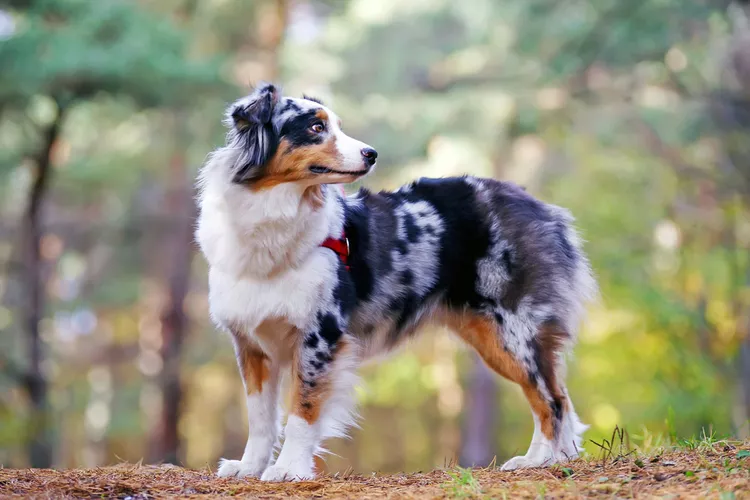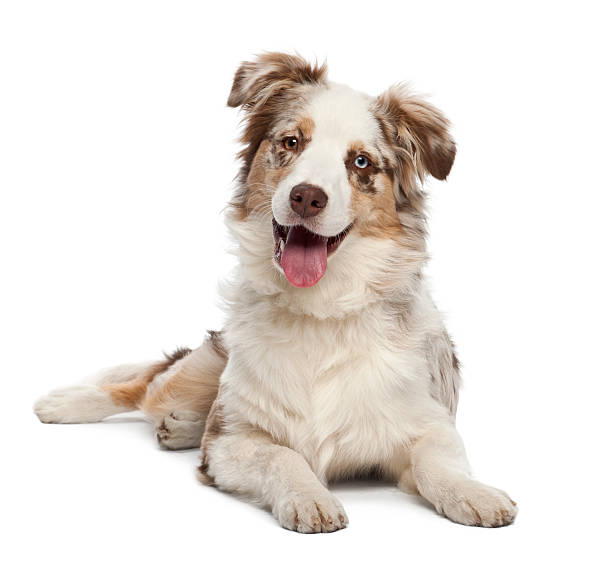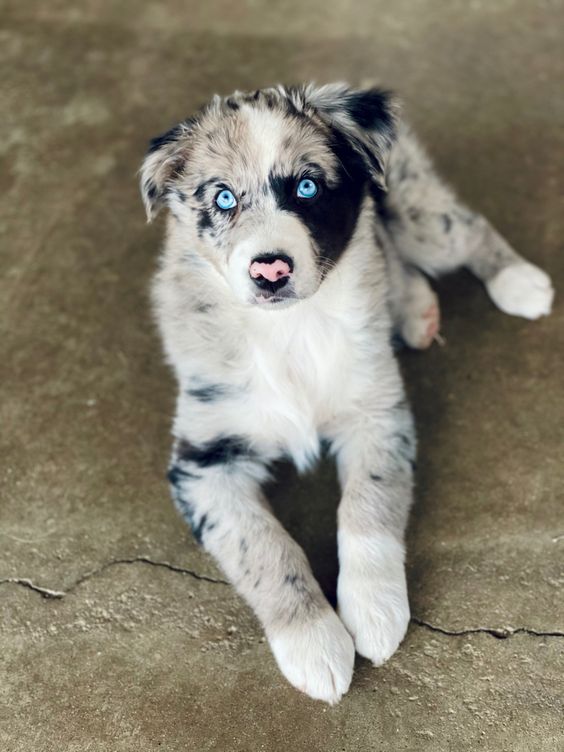Australian Shepherd Dog Breed Information
The Australian Shepherd, affectionately known as the ‘Aussie,’ is an intelligent and versatile breed that excels in herding and dog sports. Though its name can be misleading, this Australian Shepherd breed originated in the United States, as confirmed by the American Kennel Club. The Australian Shepherd is a medium-sized breed with a naturally bobbed and harsh double coat that comes in hues like blue, red, black, and red paired often with white and tan accents.
Aussies are agile, powerful, and have great stamina. They’re eager to learn and crave interaction and purposeful activities, making them an excellent match for active owners. Their notably high intelligence, loyalty, and protective instincts make Australian Shepherds the best dog for families or individuals seeking an engaging and loving pet.
Key Takeaways
- Australian Shepherds are intelligent and require active engagement.
- Despite its name, the breed started in the United States.
- Aussies boast a durable, harsh, and naturally bobbed coat in unique colours like blue and red merle.
Australian Shepherds, known as ‘Aussies,’ are intelligent and energetic. Originating not from Australia but the United States, they’re medium-sized and resilient. These dogs have a dense coat, appearing in blue merle, red merle, black, and red with white and tan markings.
Aussies are elegant and robust, with impressive endurance. They thrive on learning and need meaningful activities, which is perfect for energetic owners. Their smarts, devotion, and guardian nature make them ideal partners for families or individuals seeking an active, affectionate canine.
Quick Facts
Australian Shepherds are known for their agility, intelligence, and endurance, which make them superb working dogs. They have an innate ability to herd and guard livestock, an essential trait in their role within the Herding Group.
Adult male Australian Shepherds stand about 20-23 inches tall and weigh between 50-65 pounds, while adult females are typically smaller. These dogs are generally healthy, lasting 12 to 15 years. However, they can inherit certain health conditions, especially eye disorders. The beautiful blue merle coat is widespread but can be linked to higher risks of eye problems.
People looking to own an Australian Shepherd should know these potential genetic health issues.
Australian Shepherd Pictures






Overview
Commonly chosen for their exceptional herding abilities, Australian Shepherds excel as companion animals due to their intelligence and energetic nature. These medium-sized, robust canines present a well-balanced physique necessary for the vigorous demands of livestock management.
The breed’s unique coat, often exhibiting the merle pattern, is visually striking and serves as a marker for genetic diversity, which may predispose them to eye anomalies, necessitating careful genetic scrutiny.
The breed’s protective and loyal demeanor is complemented by an innate herding instinct, requiring owners to exert ample physical exertion to channel their energy positively. With a penchant for dog sports, Australian Shepherds demonstrate versatility beyond traditional herding roles, thriving in activities challenging their agility and obedience.
Key Traits
Australian Shepherds are known for their quick learning abilities and versatile nature, making them more than just herding dogs. They are brilliant, making them excellent at obeying and solving problems. These dogs have an instinct to herd, which has its roots in their history and sometimes shows up in their behavior with kids and other pets. They have a double coat that protects them from weather conditions but also requires regular grooming.
| Trait | Description | Relevance |
|---|---|---|
| Intelligence | Excellent at learning and solving complex problems | Helps in dog training and adapting to various tasks |
| Herding Instinct | Inclination to manage movements of groups | It prevents unwanted behavior and is vital for health |
| Double Coat | It affects how they behave around other animals and children; they need direction. | Shields against weather and needs grooming for health and looks |
| Exercise Needs | High demand for physical and mental activity | Prevents unwanted behavior and is vital for health |
| Adaptability | Can conform to different environments and roles | Allows them to excel in a range of activities, from herding animals to dog sports |
Australian Shepherds need lots of exercise to keep them from becoming destructive due to their high energy levels. They are also quite adaptable, making them a good fit for various jobs, from farm work to dog sports.
Breed Origins

The Australian Shepherd, affectionately known as the ‘Aussie,’ has a rich genetic background and a history rooted in function. The breed’s journey began with European shepherds relocating to the Western United States, bringing their dogs to manage flocks. These dogs were selectively bred on American ranches for their superior herding abilities, enhancing the breed’s skills.
Mid-20th century efforts to set official breed standards marked a significant milestone in the Aussie’s development. Since then, the breed has taken on roles beyond herding, excelling in various canine sports and becoming a beloved pet.
The Australian Shepherd’s story reflects its transformation into a well-regarded and adaptable companion for families and individuals alike.
European Ancestry Influence
Despite their misleading name, Australian Shepherds have a strong European heritage. Their ancestors include herding dogs from Spain and France, and they were further refined with Collie breeds in Australia and New Zealand.
This mix was perfected in the United States, where the breed gained popularity. The Australian Shepherd’s genetic makeup is primarily influenced by the Pyrenees Mountains’ Spanish Shepherds, known for their herding prowess and ability to navigate challenging terrain.
Through their journey with shepherds and flocks across Europe, these dogs absorbed qualities from various European herders, resulting in the adaptable and resilient Australian shepherds we know today.
Ranching Heritage Roots
The Australian Shepherd is a breed with deep roots in the American West, tracing its origins to 19th-century Californian ranches.
Initially, these dogs were bred from Australian and New Zealand collies, shaping them into a versatile herding breed that spread throughout the U.S. West, a testament to their ability to adapt to different farming environments.
Jay Lister, a notable rodeo performer, played a significant role in popularizing the breed, which became known for its exceptional sheep herding skills.
With an average height of 18 to 23 inches and weighing between 35 to 70 pounds, the Australian Shepherd’s physical build and solid herding instincts reflect its historical role in managing livestock.
These traits remain prominent today, ensuring the breed’s continued success as a ranching partner and a capable working dog.
Development Timeline Milestones
To fully appreciate the Australian Shepherd’s history, looking at how they evolved from a working herding dog in 19th-century California to the cherished breed we know today is essential.
The Australian Shepherd was created by mixing various herding dogs, including collies from Australia and New Zealand. Breeders have been crucial in fine-tuning the Australian Shepherd’s physical and mental traits, leading to a lineage that’s both smart and agile, though it carries some risk for genetic health issues.
They have been selectively bred for their high energy and intelligence, making them ideal for active families and challenging jobs. Over time, these dogs have shown remarkable versatility and a strong work ethic, gaining widespread admiration when they reached maturity.
Physical Dimensions

When you look at an Australian Shepherd, you’ll notice features showing its history as a hardworking dog and striking appearance.
These dogs have a well-proportioned height that makes them appear balanced, neither too small nor too large. They also have a weight range that showcases their strength and agility.
Their coats vary in length, which suits a range of weather conditions and practical purposes. The tail of an Australian Shepherd might be short or long, contributing to the breed’s unique outline.
These characteristics aren’t just for show; they enable the dog to perform the tasks it was bred for.
Height and Weight
The Australian Shepherd is a well-proportioned mid-sized breed. Male Aussies stand about 20 to 23 inches tall and weigh between 50 and 65 pounds, while females are slightly smaller, ranging from 18 to 21 inches and tipping the scales at 40 to 55 pounds.
Ideally, these dogs balance height and weight, contributing to their agility and stamina. In metric measurements, males are around 51 to 58 centimeters tall, and females are about 46 to 53 centimeters high.
Maintaining these breed proportions is essential for the dogs’ health and ability to work, reflecting their firm, manageable build ideal for their active lifestyle. It’s crucial for those who care for these dogs to keep their size within the breed’s standard to ensure their well-being and to honor their working dog heritage.
Build: Athletic, Sturdy
Australian Shepherds are well-built and active, with a body design that suits their energetic lifestyle. These dogs fall into the herding category, requiring a physique to handle swift moves and long work periods. Male Australian Shepherds stand about 20-23 inches tall and weigh 50-65 pounds. Their female counterparts are slightly smaller, with heights of 18-21 inches and weights of 40-55 pounds.
These measurements help them move quickly and with agility. Their muscular hips and legs support their ability to maintain speed and perform impressive jumps. An Australian Shepherd’s double coat is of moderate length, and their unique walking style, where their legs cross over, adds to their sturdy nature.
This physical build is not just for looks; it serves a practical purpose in their traditional herding roles and other activities that require stamina and strength.
Coat Length Variations
Australian Shepherds sport a medium-length coat that varies, usually between 1.5 to 3 inches. The length can change based on each dog’s genes and living conditions.
They have a double-layered coat with a thick undercoat for warmth and a longer, weatherproof topcoat. This versatile fur suits many weather conditions by keeping the dog warm or cool as needed.
When shedding season comes around, Australian Shepherds lose more hair, so owners need to brush them more often to keep their coats tidy.
The longer hair around their neck and legs isn’t just for looks; it also gives extra protection against harsh weather.
Tail: Bobbed or Full
Australian Shepherds can sport two different tail styles: naturally short or the standard long tail.
A bobtail might be under four inches, whereas a full tail can reach the hock and sometimes more.
The shorter tail trait comes from a genetic mutation leading to fewer vertebrae, giving some Aussies this distinct look. Initially, this was beneficial for preventing injuries in herding tasks, but today, it’s more about the breed’s looks.
On the other hand, an Australian Shepherd with a full tail has all its caudal vertebrae, and its length is set by genetics, often showing off the breed’s signature plume when it’s not docked.
Breed standards welcome both tail types to maintain the genetic variety within Australian Shepherds.
Gender Size Differences
Male and female Australian Shepherds show noticeable size differences, with males typically being more significant in height and weight. A male Australian Shepherd usually stands between 20 and 23 inches tall and weighs 50 to 65 pounds, while females are often 18 to 21 inches tall and weigh around 40 to 55 pounds.
These size variances are common in medium-sized dog breeds and can affect their behavior, health, and suitability for various activities or as pets. For example, the bigger build of male dogs might make them more prone to hip dysplasia, a critical health issue for Australian Shepherds.
When breeding, providing medical care, or assigning work, it’s essential to consider these gender-specific physical characteristics.
Behavioral Characteristics

Australian Shepherds have a strong temperament herding instinct, often showing a natural ability to guide and control the movement of other animals or even people. They are also protective, always alert to guard their home and loved ones.
These dogs have abundant energy, requiring plenty of exercise to stay healthy in mind and body. Their sharp intelligence makes them quick learners, but they need engaging and consistent training to keep their minds active.
For anyone considering an Australian Shepherd, it’s crucial to understand these traits to provide a nurturing environment for the dog.
Herding Instincts
Australian Shepherds naturally tend to herd, as evidenced by their interactions with animals and people. This behavior isn’t just a random trait; it’s a part of their heritage, carefully selected over time to help manage livestock efficiently.
Owners might notice their Aussie trying to gather other pets or children, a behavior that stems from their ingrained desire to organize and guide the movement of a group. Studies of their movement patterns show a distinctive gait where their legs crisscross, likely developed to help them make quick and sharp turns while herding.
Their strong legs and hips are built for sudden sprints and impressive leaps, showcasing their herding skills.
Protective Nature
Australian Shepherds are highly vigilant and possess protective solid instincts that make them excellent at keeping their families safe. These dogs are profoundly loyal and always alert, making them outstanding watchdogs. Australian Shepherds think independently, which helps them react quickly to any danger.
Their natural herding behavior often turns into protectiveness, especially around children or other family pets. While they may act distant around strangers, this behavior is part of their guarding instinct. Owners should socialize them well to avoid any issues with overprotectiveness.
If guided properly, their desire to make their owners happy can result in a well-adjusted and temperate companion.
Energy Levels
Australian Shepherds are energetic dogs that need lots of engaging activities to keep them happy and well-behaved. They come from a working animal heritage, so they need plenty of exercise to satisfy their physical and mental needs.
If they don’t get enough stimulation, Australian Shepherds might start to act out. To keep them content and mentally sharp, getting them involved in dog sports can be a great way to meet their exercise and mental challenges. When their exercise needs are met, these dogs are at their best, but they can become anxious or get into mischief without enough to do.
Trainability Challenges
Training Australian Shepherds can be tricky due to their brilliant but independent nature, which sometimes comes off as stubbornness. Consistent training that uses positive rewards works best for them.
These dogs also have a particular health note: they can be sensitive to Ivermectin, a parasite medication, so always consult a vet before treatment.
To help these dogs get along with new people and manage their strong herding drive, start socializing them early and keep it up.
Since they tend to bark a lot as part of their watchdog duties, providing lots of mental exercises to prevent unwanted behaviors is good.
Socialization Importance
Introducing an Australian Shepherd puppy to various people, animals, and environments early on is essential for their development. This brilliant breed requires mental stimulation through social experiences to prevent the onset of negative behaviors. Exposing Australian Shepherd puppies to different situations helps them develop a more flexible brain, making it easier for them to learn and adjust as they grow.
Socialization plays a crucial role in their potential to become well-behaved family members.
It also helps manage their herding solid instincts, which, if not guided properly, might lead to them trying to herd children or other animals. A consistent approach to socialization ensures these energetic and alert dogs fit nicely into various social settings, behaving confidently and following commands.
Common Health Concerns

Australian Shepherds are generally healthy and energetic but can inherit certain medical conditions. These include hip dysplasia and various eye problems that may get passed down through their genes. For Australian Shepherds, a typical lifespan ranges from 12 to 15 years, and these genetic health issues can impact how long they live.
Preventive actions, like consistent health check-ups and genetic tests, can help manage and potentially reduce the risk of these hereditary diseases. Responsible breeding is also crucial in minimizing genetic health problems, particularly those related to the merle gene, which can affect coat color and health.
Understanding these factors is critical to ensuring the well-being of Australian Shepherds.
Hereditary Disease Risks
Australian Shepherds have a genetic makeup that makes them vulnerable to certain hereditary diseases such as Collie eye anomaly, cataracts, and a particular drug sensitivity caused by the MDR1 gene mutation. Another major health issue in the breed is hip dysplasia, a painful condition where the hip joints are malformed and can deteriorate over time, affecting the dog’s ability to move.
Besides joint issues, these dogs can also face hearing and vision problems, some of which they are born with. Conditions like Collie eye anomaly (CEA) and persistent pupillary membranes can vary in severity, but the worst cases may lead to blindness. Screening for these conditions is vital because knowing about them early on and choosing healthy breeding pairs can reduce these problems in future generations of Australian Shepherds.
Lifespan Averages
Australian Shepherds generally enjoy good health but face health concerns that can affect their lifespan. Orthopedic issues like hip dysplasia, a genetic disorder causing improper hip joint formation, can be painful and hinder movement. Spotting these problems early through regular screenings can make a big difference in managing their health.
Another concern for Australian Shepherds is the MDR1 gene mutation affecting how they process certain medications. Knowing this, vets can tailor treatments to avoid complications.
Ethical breeding, which includes comprehensive genetic testing and attention to joint health, is critical to ensuring the well-being of these intelligent and energetic dogs.
Preventative Health Measures
Like other breeds, Australian Shepherds face specific health challenges that need monitoring. Regular eye exams and genetic testing are vital to catch hereditary conditions early on. Keeping an eye out for hip dysplasia is essential, as this condition can be affected by both genes and the environment. Including elbow dysplasia checks in your dog’s health routine is wise because it can seriously hinder their movement if it develops.
Protecting your Australian Shepherd from too much sun is essential to prevent nasal solar dermatitis, especially for those with light-colored noses. For progressive retinal atrophy, which can cause blindness, genetic tests can help owners make informed breeding decisions.
Maintenance Requirements
Grooming Needs
To keep an Australian Shepherd’s thick coat healthy, brush them at least every two weeks. This routine helps manage shedding and keeps their fur in good condition.
Exercise Requirements
Australian Shepherds have a lot of energy and need plenty of exercise. Aim for at least one hour of vigorous activity daily to keep them fit and happy.
Diet and Nutrition
These dogs are very active, so giving them the right amount of food packed with nutrients is crucial. This ensures they get the energy they need without overfeeding.
Healthcare and Vet Visits
Regular check-ups, preferably every six months, will help catch any health issues early. This is especially important for Australian Shepherds with breed-specific health concerns.
Grooming Frequency
Australian Shepherds are well-known for their beautiful coats. Keeping them in top condition means regular grooming. Brushing their medium-length, double-coat a few times each week is necessary. The undercoat is thick, and the top coat is wavy, which can easily tangle, especially around the neck where a mane and frill are present.
Paying close attention to the legs and tail is essential, too, as they have moderate feathering that can mat if ignored. Regular brushing helps prevent knots and evenly spreads the dog’s natural oils, keeping their coat shiny and healthy. This practice isn’t just for looks; it also helps prevent skin problems.
Exercise Regimen
Australian Shepherds are intelligent, energetic dogs that need regular activity to stay happy and prevent behavioral issues. To keep them healthy and dodge problems linked to inactivity, owners need to provide at least an hour of vigorous play or exercise daily.
This can be a mix of running with their owner and engaging in dog sports that tap into their instincts, like agility, obedience, or herding trials. These activities keep them physically fit and mentally sharp, which is critical for the overall wellness of this active breed.
Nutritional Needs
Feeding an Australian Shepherd correctly is vital for their well-being and vitality, mainly because they are energetic and need plenty of exercise. These medium-sized dogs are intelligent and active, so a protein-rich diet is vital for keeping their muscles strong and healthy. They also need the right balance of fats for lasting energy and carbohydrates for a quick energy surge, which helps them stay active and fit.
Watching what they eat to avoid health issues like hip dysplasia is essential. Adjust their food daily to suit their exercise levels, making sure they stay at a healthy weight.
Choosing the right food for your Australian Shepherd means looking for quality ingredients that meet their high energy demands. Adjust their portions based on how much they exercise to keep them in great shape.
Health Check Schedules
Regular vet visits are essential for Australian Shepherds to prevent and manage health issues unique to their breed, such as eye conditions, hip dysplasia, and sensitivities linked to the MDR1 gene.
Regular full-body check-ups can catch hip dysplasia early. This condition affects the hip joint, leading to severe pain and arthritis if left untreated.
Eye exams by a specialist should be part of the routine to spot problems like iris coloboma, which can affect your dog’s vision.
It’s also wise to get a genetic test for the MDR1 mutation. This genetic trait can make standard medications dangerous for your dog.
Keeping up with these health checks can keep your Australian Shepherd healthy and happy.
Training Commitment
Training an Australian Shepherd requires a solid commitment due to their intelligence and need for regular mental stimulation and exercise. These dogs excel in problem-solving and are versatile, making them great for challenging roles like search and rescue.
Training goes beyond basic commands and includes activities that engage their instinctive behaviors. It is crucial to use positive reinforcement methods to guide their herding tendencies and avoid potential behavioral issues.
Australian Shepherds are well-suited for intensive training, which meets their mental and physical needs.
Dietary Needs
Australian Shepherds have specific dietary needs tailored to their active lifestyle and health requirements. A well-planned diet for an Australian Shepherd should include the right balance of proteins, fats, and carbohydrates to meet their energy needs.
Including vitamins and minerals that target their specific health risks is also vital. Care should be taken to identify any food sensitivities to prevent adverse reactions.
It’s also essential to determine the proper number of meals daily to match their metabolic rate and avoid overeating, which can lead to weight issues and other health complications.
Nutritional Requirements
Australian Shepherds are energetic and agile and need a protein-rich diet to keep up with their lifestyle. These intelligent dogs have high activity levels, so their food should fuel their minds and bodies. Proteins are vital for maintaining muscle mass, essential for active breeds like them. It’s also necessary to feed them a diet with the right balance of fatty acids, vitamins, and minerals to prevent health issues, including vision problems and hip dysplasia.
Managing their food intake is critical; too many calories can lead to obesity and stress on their joints. A vet can help design a diet that fits their unique needs, keeping them happy and healthy. Regular check-ups ensure their meals meet their energy requirements without going overboard, allowing them to stay in great shape.
Food Sensitivities
Australian Shepherds are energetic and have specific dietary needs to keep them healthy and active. These dogs need the right mix of nutrients to fuel their busy days. But there’s a twist: Australian Shepherds have a unique genetic trait linked to the MDR1 gene, making their diet and medication choices more complex. Breed experts emphasize tailoring their meals to avoid bad reactions to certain medications.
A diet not well-suited to an Australian Shepherd can cause food sensitivities, even if no apparent signs exist. Pet owners and vets must work together to find the best food for these dogs. They must also be vigilant about medication sensitivities that could affect the dogs’ health and zest for life.
Feeding Frequency
It’s essential to figure out the best feeding schedule to keep your Australian Shepherd in top shape. Since they’re brilliant and need lots of activity, Australian Shepherds thrive on a diet that suits their energetic lifestyle.
Twice-daily feedings are recommended to help maintain their fast metabolism and to reduce the risk of severe health issues like bloating. A consistent feeding routine with measured portions will support their active days and help prevent digestive problems.
This approach helps control their weight and steady their energy levels, allowing them to stay alert and responsive.
